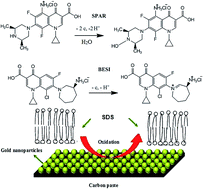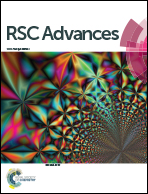Determination of sparfloxacin and besifloxacin hydrochlorides using gold nanoparticles modified carbon paste electrode in micellar medium†
Abstract
A gold nanoparticles modified carbon paste electrode (AuCPE) was used to study the electrochemical behavior of sparfloxacin HCl (SPAR) and besifloxacin HCl (BESI) using cyclic and differential pulse voltammetry modes in the presence of micellar medium. Effect of different surfactants on peak current was studied in Britton–Robinson buffer solution of pH 2. Sodium dodecyl sulphate is the optimum surfactant based on the enhancement of the peak current. The modified electrode shows highly sensitive sensing giving an excellent response for SPAR and BESI. The peak current varied linearly over the concentration ranges from 1.1 × 10−7 mol L−1 to 3.3 × 10−6 mol L−1 and from 2.2 × 10−6 mol L−1 to 5.5 × 10−5 mol L−1 with determination coefficients of 0.9976 and 0.9984 in case of SPAR and BESI, respectively. The recoveries and the relative standard deviations were found in the following ranges: 99.97–101.4% and 0.63–1.48% for SPAR and 99.89–101.1% and 0.85–1.76% for BESI. The detections limits were 2.87 × 10−8 and 3.76 × 10−7 mol L−1 for SPAR and BESI, respectively. The proposed method has been successfully applied to determine SPAR and BESI in biological fluids.


 Please wait while we load your content...
Please wait while we load your content...